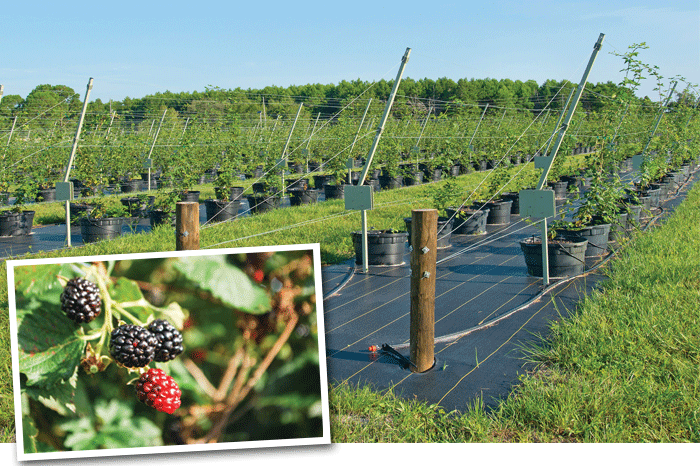Frontier farmers take a step back to black with this alternative crop
TOO MUCH HANDLING will ruin them, they are time-consuming to harvest, and sometimes they have thorns — but consumers love blackberries, and they are a viable fruit to be grown as an alternative to citrus in Florida.
Those are a few of the observations and thoughts expressed by frontier agriculturists who are venturing into the pampered world of the blackberry in Central Florida. Charles Counter of Winter Haven, who grows organic blueberries for Uncle Matt’s, says he may have only a small portion of land dedicated to blackberries now, but they are growing and fruiting well.
They are costly to grow — lots of labor involved — and they are not exactly tough berries. “Blackberries are very, very sensitive,” he says. “They must be taken off the bush and go straight into the clamshell. Then the clamshell goes immediately into a refrigerated trailer, and directly afterward into our shipping cooler, where they are shipped to retail within 24 hours.”
And no matter how challenging they are to grow and harvest, they are loved, Counter points out. “Granted, we only have a limited supply of blackberries,” he continues, “but we have not had a problem finding buyers.”
The berries are fast-growing, and Counter has his on a rotating trellis system. That has many advantages, including limiting exposure to sunburn and the ability to harvest most of the crop on one side of the trellis. Blackberries don’t all decide to be ready at once, he says. “There’s a lot of manpower involved in the harvest,” he observes. The maturity varies a lot on each bush. You need to harvest each plant every other day to be sure none of the berries become over-ripe.”
His recent venture into blackberries is what Jorge Salmeron, of Blue Gold Growers in Plant City, likes to hear. Salmeron has his eye on selling plants to interested growers — and maybe growing them himself eventually. He says he saw the opportunity forming for the blackberry plant business and hopped on the bandwagon a few years back. Already into blueberries, he realized that citrus growers were looking for a variety of ways to expand their horizons and grow alternative crops. Blackberries, he says, were obviously about to become an interesting option.
“I saw opportunity coming, of blackberries being an alternative crop to add additionally to other crops,” Salmeron explains. “The blueberries had already been out there, but blackberries — we really hadn’t heard about them much. Going back, probably about three years, I started to see ads about them being grown here. But still, people weren’t really jumping into them until about a year and a half ago.”
And when they seemed about to catch on, Salmeron points out, he began to try out variations of blackberries in small quantities at first. A variety called Prime-Ark Traveler has his attention, and he’s looking into others as well. He sees the value in thorn-less blackberries, and has focused on them. He gets the plants going and sells them to growers. He also wants to sell them to individuals who may want to pick up a few plants at a big-box store. “That’s kind of what I’m hoping for; I am looking into expanding or exploring avenues for my plants. Hopefully, I may be getting my plants into stores such as Lowe’s. That’s kind of my personal goal.”
Mary Beth Henry, a UF/IFAS Extension agent based in Bartow, says she’s hearing from growers here and there who are either trying out a few acres of blackberries or thinking about them for the future. “We don’t have a lot of people growing them, but some of the major berry growers planted test plots,” she says. While they are marketable and desirable, they have their issues, according to Henry. “Perishability is difficult,” she adds. They certainly won’t replace citrus, but blackberries have their allure. “It’s definitely interesting,” she continues. “I think if people are looking for it as a substitute for citrus, it probably is not going to make it. They are labor-intensive, and so perishable. But in small quantities, it makes sense as a variation.” “They will definitely grow here,” Henry states. “I actually have a small plot of five to six plants in the demonstration plot I have here at the office.” She keeps various plants growing there so she can show how they develop and use them as an educational tool. So how are those blackberries coming along? She replies, “They are doing gangbusters.”
FOR MORE INFORMATION, growing details are available on blackberries in a paper provide by the University of Florida IFAS Extension Office. You can access it at http://edis.ifas.ufl.edu/hs104.
CREDITS
story by MARY TOOTHMAN
title photo by PEZZIMENTI
inset photo by CAITLIN HALL

